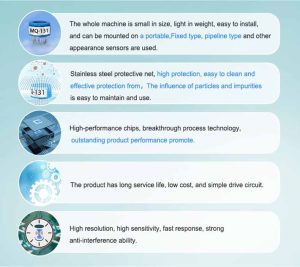In recent years, the concept of smart cities has gained significant attention worldwide. These cities aim to enhance the quality of life for residents by integrating technology and data to optimize various aspects of urban living. One essential aspect is ensuring the safety and well-being of citizens by monitoring air quality. This article explores the applications and benefits of Internet of Things (IoT)-enabled gas sensor networks in creating smart cities.
Monitoring Air Quality:
Air pollution is a growing concern in urban areas, impacting public health and the environment. IoT-enabled gas sensor networks provide real-time and accurate monitoring of air quality parameters, such as pollutants like carbon monoxide, nitrogen dioxide, and particulate matter. These sensors are strategically placed throughout the city, forming a network that continuously collects and analyzes data. By having a comprehensive view of air quality in different areas, city authorities can take prompt actions to mitigate pollution sources, improve ventilation systems, and implement effective policies to protect residents' health.
Early Detection of Gas Leaks:
Gas leaks pose significant risks in urban environments, including the potential for explosions and fires. IoT-enabled gas sensor networks can detect leaking gases, such as natural gas and propane, in real-time. These sensors transmit data to a central control system, which can then trigger alarms and alerts to appropriate authorities or emergency response teams. Early detection allows for rapid intervention, preventing potential disasters and ensuring the safety of citizens and infrastructure.
Optimizing Urban Planning:
Smart cities require efficient urban planning to ensure sustainable development. By deploying gas sensor networks, city planners can gather accurate data on pollutant levels and identify areas that require immediate attention. This information enables them to make informed decisions regarding zoning regulations, land use, and transportation infrastructure to minimize pollution sources and create healthier living environments. IoT-enabled gas sensor networks thus empower city planners to build environmentally friendly and sustainable cities.
Public Awareness and Engagement:
Gas sensor networks with IoT connectivity provide an opportunity for public awareness and engagement. Real-time data on air quality can be shared with residents through mobile applications or public displays, enabling citizens to understand the environmental conditions they are exposed to daily. This information promotes public awareness and empowers individuals to make informed choices about outdoor activities, route planning, and the use of personal protective measures. Moreover, citizens can actively contribute to pollution reduction efforts by reporting unusual odors or environmental concerns to authorities, leveraging the power of community engagement.
Enhancing Emergency Response:
In the event of a gas leak or other hazardous situations, IoT-enabled gas sensor networks play a crucial role in enhancing emergency response capabilities. The network can detect gas leaks quickly and accurately, providing immediate alerts to emergency services. Additionally, the sensor data can assist responders in understanding the scale and extent of the situation, facilitating more effective and targeted response actions. By improving emergency response times, gas sensor networks contribute to the overall safety and resilience of smart cities.
Conclusion:
IoT-enabled gas sensor networks have significant applications and benefits in creating smart cities. By continuously monitoring air quality, detecting gas leaks, optimizing urban planning, promoting public awareness, and enhancing emergency response, these networks play a pivotal role in ensuring the safety and well-being of residents. As smart city initiatives continue to evolve, the integration of gas sensor networks will become essential for building sustainable and livable urban environments.
 : +86 155 8830 2704
: +86 155 8830 2704 : jxdziot@gmail.com
: jxdziot@gmail.com
